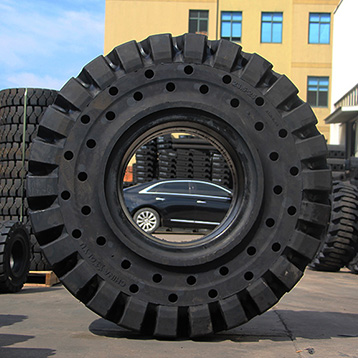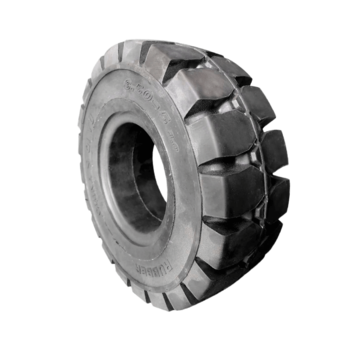The Press-on Solid Tire for Electric Forklift Truck is an essential component in material handling operations, designed to provide durability, stability, and long-lasting performance in demanding industrial environments. Unlike pneumatic tires, press-on solid tires are made from solid rubber or a rubber-based compound and are mounted directly onto the wheel hub without the need for air pressure. The selection of raw materials for these tires is a critical factor that determines their overall performance, safety, and lifespan.

1. Rubber Compounds: The Core Material
The primary raw material used in the production of Press-on Solid Tire for Electric Forklift Truck is rubber, which forms the foundation of the tire's structure. Rubber compounds are specially formulated to balance the need for strength, elasticity, and wear resistance while maintaining adequate grip and stability. The selection of rubber compound depends on various factors such as the weight capacity of the forklift, the surface conditions it will operate on, and the expected load cycles.
The two main types of rubber used in tire manufacturing are natural rubber and synthetic rubber. Natural rubber provides high tensile strength and elasticity, making it ideal for producing durable and flexible tires. However, it is sensitive to heat and ozone degradation. On the other hand, synthetic rubbers such as styrene-butadiene rubber (SBR), butadiene rubber (BR), and ethylene propylene diene monomer (EPDM) offer enhanced resistance to aging, ozone, and temperature extremes. For Press-on Solid Tire for Electric Forklift Truck, a combination of both natural and synthetic rubbers is often used to achieve the right balance of performance characteristics.
2. Fillers and Reinforcements
To enhance the properties of the rubber and improve the tire's strength, durability, and resistance to wear, various fillers and reinforcements are added to the compound. These materials help optimize the performance of the tire, particularly in high-demand environments such as warehouses or distribution centers where forklifts operate on hard concrete surfaces for extended periods.
Carbon Black: Carbon black is a commonly used filler material in the production of Press-on Solid Tire for Electric Forklift Truck. It reinforces the rubber, providing strength, durability, and abrasion resistance. Carbon black also enhances the tire's ability to withstand UV degradation and ozone exposure, thus improving its lifespan.
Silica: Silica is another filler material used in modern rubber formulations. Compared to carbon black, silica offers better rolling resistance and improves fuel efficiency. Although silica is more expensive, it can contribute to a smoother, quieter ride and can be used to enhance grip on smooth surfaces.
Polymeric Resins: Polymeric resins are used to modify the rubber compound's hardness and improve the tire's ability to withstand compression. The selection of the right resin can influence factors like tire stiffness, wear resistance, and overall load-bearing capacity.
Reinforcing Agents: In addition to fillers, various reinforcing agents like steel or polyester fibers can be incorporated into the rubber compound to enhance strength and support. These reinforcements improve the tire's resistance to deformation and ensure that it can handle heavy loads without premature wear.
3. Plasticizers and Softening Agents
To achieve the desired flexibility and elasticity in Press-on Solid Tire for Electric Forklift Truck, plasticizers and softening agents are added to the rubber compound. These substances reduce the hardness of the rubber, enabling the tire to absorb shocks and impacts effectively while maintaining a level of pliability that ensures stability.
Oil-based plasticizers are commonly used to improve the processing of the rubber and enhance its flexibility, making it easier for manufacturers to mold and shape the tire during production.
Synthetic oils such as paraffinic or naphthenic oils may also be used for their ability to improve low-temperature flexibility and to reduce the overall cost of the tire while ensuring adequate durability and performance.
 View More
View More
 View More
View More
 View More
View More
 View More
View More
 View More
View More
 View More
View More
 View More
View More
 View More
View More
 View More
View More
 View More
View More
 View More
View More
 View More
View More